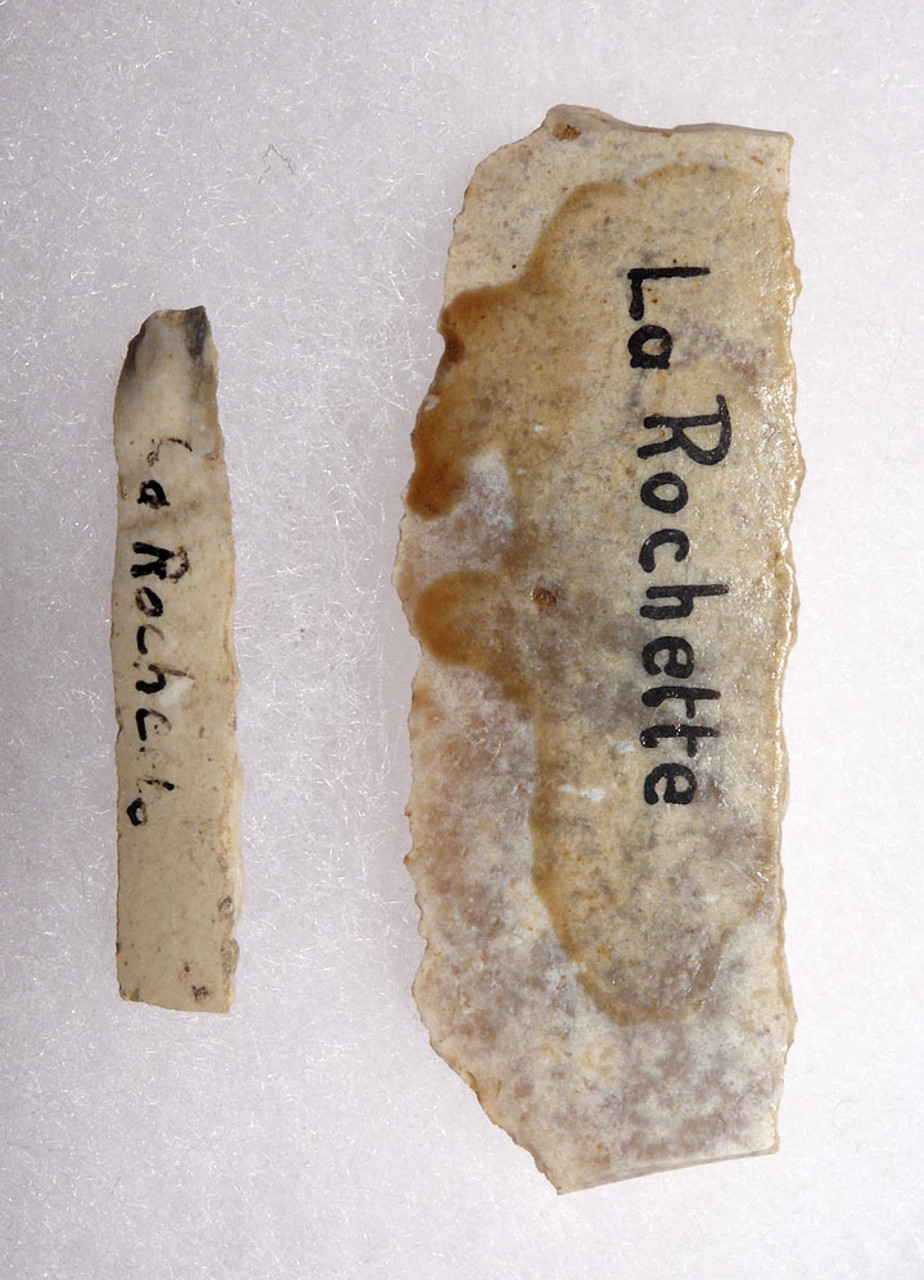Product Description
For comparison prices, please see the "Old World Typology and Price Guide" section of the "OVERSTREET IDENTIFICATION AND PRICE GUIDE TO INDIAN ARROWHEADS" editions 7th, 8th and 9th.
SEE MORE UPPER PALEOLITHIC TOOLS
This is a set of TWO genuine flint STRUCK BLADES of the Upper Paleolithic Aurignacian culture. One is extremely rare in its small size. Both were made by striking a prepared blade core to split off a longitudinal flake blade. These tools were found in the important La Rochette rock shelter site, one of the rare Paleolithic sites famous for producing Cro-Magnon fossil remains. The site is located in the Department of Dordogne, France, a major locale of prehistoric human occupation. Tools like this are specifically attributed to the Upper Paleolithic Period. All these sites have long been closed and protected from private collecting making this offering one of a limited and special opportunities to collectors.
Both of these blades are of the finest condition and are complete with the worked ends and base showing the striking platforms. Many Paleolithic blades like these are broken and incomplete, not whole as both of these superb specimens are. Both blades are made of flint with a heavy prehistoric patina and show EXTENSIVE prehistoric secondary flaking and re-sharpening down their long cutting edges. Core struck blades like this are a classic tool type most attributed with the Upper Paleolithic period. From these struck blades, many different tools were fashioned by further flaking and shaping. It is with intact mineral deposits deep in microscopic micro-crevices and lacks any modern flaking or crushing, traits only seen in authentic prehistoric stone tools.
No collection of Paleolithic stone tools would be complete without the inclusion of fine examples dating to the Upper Paleolithic Period. This was an era of many of the most famous human development milestones. In this period, the technology developing around the planet took place at slightly different times but globally, humanity was taking a huge turn for the better, and in overall unison. A new level of tool production and craftsmanship emerged unlike ever seen before. Modern humans first arrive on the scene and with them, they bring many new inventions - most notable is the concept of artistic expression as seen in the famous cave paintings that were only produced in this era.
Because the majority of sites that are known to produce Middle and Upper Paleolithic artifacts have been long protected by government regulations and are off-limits to private collecting, the only way to acquire specimens is from old collections that predated these restrictions. As these sites have been off-limits for decades, genuine fine grade Neanderthal and Cro-Magnon human artifacts such as this specimen are most certain to continue to appreciate in value, as time goes on. Paleolithic tools from important sites like this are fast appreciating in value, their sites having been protected and closed to collecting for many decades now.
HISTORY
The famous La Rochette rock shelter site, close to Saint-Leon-sur-Vezere, was first excavated by Otto Hauser in 1910. The studies revealed continual human presence in the form of flint tools and animal remains, from the Mousterian to the Magdalenian cultures. It is famous for the discovery of a Cro-Magnon human fossil in the form of a right ulna that was dated to 23,000 years old, of the Gravettian culture. While many Paleolithic sites in Europe have produced stone tools, the few that produced actual human fossils are rare and at the zenith of scientific importance. La Rochette is one of these important sites!
The Upper Paleolithic was an important dawning of a new age in human history and development. In this period, we find the earliest evidence of organized campsite settlements, some that had storage pits. Human artistic expression blossomed in the form of non-portable art such as cave painting and carved petroglyphs, and portable art such as bone or ivory carvings and engravings. The first evidence of human fishing is also found with the discovery of carved harpoons and hooks. It is likely that warfare amongst people increased as complex social structures emerged with an increasing availability and variety of food, as well as specialized tool types.
 US DOLLAR
US DOLLAR
 EURO
EURO
 AUSTRALIAN DOLLAR
AUSTRALIAN DOLLAR
 CANADIAN DOLLAR
CANADIAN DOLLAR
 POUND STERLING
POUND STERLING




















